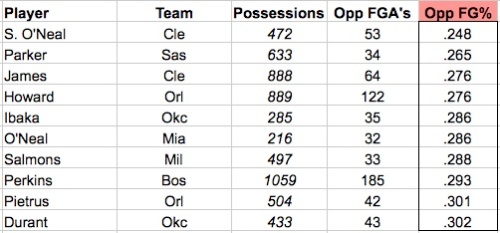I’ve talked about “guarded situations” before, but never from the perspective of an individual defender. We can use a “guarding situation” as a quick and dirty operational definition for looking at FG% against individual defenders. To reiterate the definition of a guarded situation:
- The defender is trying to defend an offensive player without being impeded by a screen or helping on defense
- The defender is challenging an offensive player at the basket by “engaging” in guarding them
- The defender is double-teaming in a manner that actually impacts the opponent’s shot
The first situation has a gray area when players are screened out and then “re-engage” in guarding them (or switch on screens and pick up a new man). I look at the defenders stance and spacing from the offensive player to determine if he’s re-engaged: If the defensive player hasn’t had time to establish that position as he otherwise would have, he hasn’t engaged the offensive player again. (For eg, scrambling and lunging at a shot attempt from 4 feet away after being screened isn’t “guarding,” it’s more akin to closing out on a jumper shot.)
The second situation is fairly straightforward — Dwight Howard isn’t engaged in “guarding” a player by leaping across the lane at the last second, after a shot is taken, trying to block it. That’s the equivalent of a closeout on a jump shot, and for these purposes ignored (unless the shot is literally blocked). But when he’s standing in the lane and picks up the attacker coming toward the rim, he is now guarding the offensive player.
The last situation is simply to clarify that an incoming double-team is not an engaged double-team. If Dwayne Wade runs at a post player to double, he isn’t actually guarding him until he gets there. Engaged double- teams count as half attempts for each defender.
From that definition, we can look at how players shoot against defenders. The average guarded shot in 164 team games tracked this year is 40.6%. In last year’s playoffs, it was 39.6%, mostly due to the number of games played by good guarding teams like Boston (35.6% against), Orlando (36.6% against) and Los Angeles (38.0% against).
Here are the individual leaders from the 2010 playoffs in FG% against (min 30 FGA):
There are some not-so-surprising names on that list. Players with good defensive reputations like LeBron James, Howard, Serge Ibaka and Kendrick Perkins. Although it’s always important to keep in mind that playoff samples are heavily influenced by the matchups from a series or two.
There are surprising names there too, perhaps most notably Tony Parker. After 26 FGA against this year, Parker’s opponents are shooting 50%. Ah, small sample sizes! Here are the leaders from games tracked in the regular season so far this year (min 30 FGA):
Again, it might be surprising to see Jason Kidd’s name there, but he just missed the cut for the playoff leaders last year — 31.3% against. Even at his advanced age, he can still defend quite well, and I imagine his large frame and intelligent positioning make scoring on him more difficult than normal.
Another name that might stand out, other than Shannon Brown, is Derek Rose. I will have a post on Rose and the Bulls defense in the near future, but there is no doubt Rose’s athleticism has made him a really solid defender at the point guard position.
Included here is the complete list of qualifying players in FG% against from 2010 playoffs.





